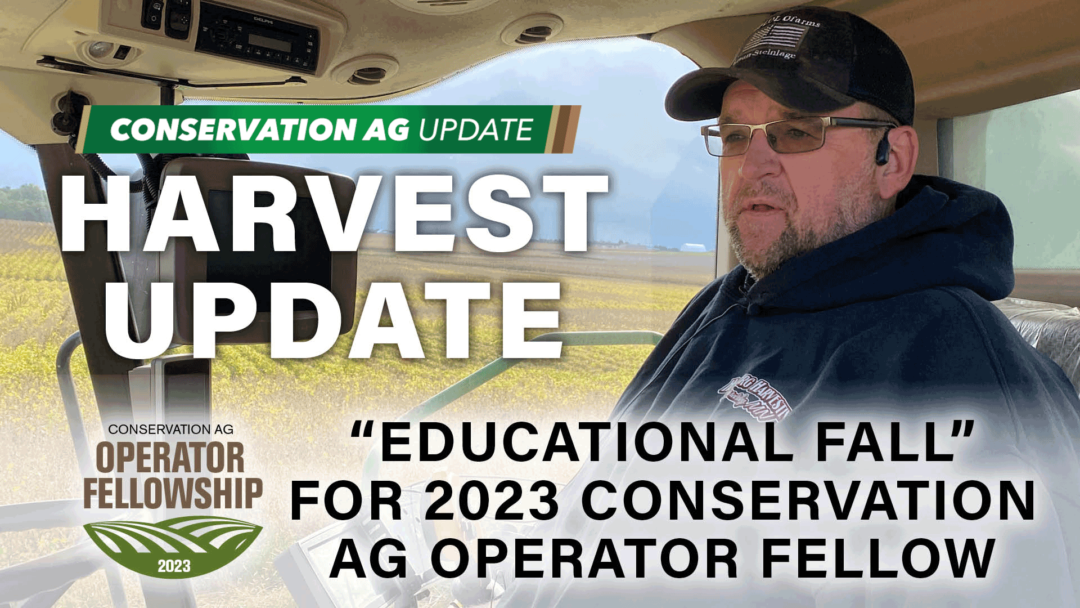On this episode of Conservation Ag Update, brought to you by CultivAce, West Union, Iowa, no-tiller Loran Steinlage checks in with a harvest update, and explains why this fall will be one of his most educational harvests yet.
Also in this episode, Dr. Ben West, executive director of Farmers for Soil Health, identifies 2 key factors that will drive no-till, strip-till and cover crop adoption rates.
In the Cover Crop Connection, assistant editor Mackane Vogel takes us inside Spring Green, Wis., farmer Gary Zimmer’s field day for a look at his unique approach to cover crops and soil fertility. Plus, Vanderloop Equipment demo’s an autonomy kit for a customer near Fort Atkinson, Wis., and No-Till Innovator Phil Needham shares some of his top tips for achieving high yields with no-till wheat.
This episode of Conservation Ag Update is brought to you by CultivAce.
CultivAce is a West Coast manufacturer and distributor of a comprehensive line of foliar and starter fertilizers. CultivAce offers innovative solutions that drive agricultural crop yields and cultivate profitableoutcomes.
With a relentless focus on delivering the highest quality foliar and starter fertilizers, we are committed to empowering growers with the tools they need to achieve remarkable results. CultivAce is built on two fundamental principles: products must be the highest quality, and they must make the grower money. If a product doesn’t meet these standards, CultivAce doesn’t manufacture it.
For more information go to CultivAcegrowth.com.
TRANSCRIPT
Jump to a section or scroll for the full episode...
- Harvest Update: “Educational Fall” for 2023 Conservation Ag Operator Fellow
- 2 Keys to Increasing No-Till/Strip-Till Adoption Rates
- Using Cover Crops for Root Structure & Residue
- head of the Curve: Behind the Scenes of an Autonomy Demo
- Tips for No-Tilling Wheat into Soybean Residue
Harvest Update: “Educational Fall” for 2023 Conservation Ag Operator Fellow
If harvest season was a football game, we’d be kicking off the 3rd quarter! 45% of corn and 62% of soybeans are harvested according to the latest USDA Crop Progress Report. Fun fact — that soybean number is actually 10% ahead of the 5-year average.
Let’s check in with Loran Steinlage, No-Till Farmer’s 2023 Conservation Ag Operator Fellow. The West Union, Iowa, no-tiller was 50% done with corn after the 1st week of October. He says corn yields are looking good, despite only getting 10 inches of moisture since planting. The jury’s out on soybeans. But with all that’s happened this year, Steinlage says it’s going to be an interesting, educational fall.
“Ever since we’ve started with the cover crops, you’ve never seen this much change in the soil types. This hilltop behind us is a gravel knoll, and there’s actually going to be beans there this year. On a normal dry event, that area would’ve been burned up. The neighbors, last couple days, have been running 8-9% beans. Our beans just aren’t dying. Does soil health pay? I don’t know, I guess we’ll see when we harvest. I’m a little shocked about the variability this year. The covers and no-till have helped us even out the yield maps. But this year, is it the extreme showing up, or what is it? I’m wondering — Do we have tile line overloads not showing up where we have extra moisture in those areas? There will be a lot to sift through, analyze and figure out what happened out here.”
53% of corn in the U.S. is in good to excellent condition, same as last year. 52% of soybeans are in good to excellent conditions, down 4% from last year.
2 Keys to Increasing No-Till/Strip-Till Adoption Rates
Switching gears now to a prediction that grabbed our attention. Strip-till could become the predominant tillage system in Minnesota by 2026. That’s what Minnesota Agricultural Resource Center executive director Warren Formo believes, and he explains why in an article by Frank Lessiter on StripTillFarmer.com. But this begs the question, what will it take to drastically increase no-till and strip-till adoption rates? Dr. Ben West, executive director of Farmers for Soil Health, shares 2 big keys.
“We think a really big key to enhance adoption of cover crop, strip crop, no-till, is technical assistance. If you talk to farmers who have used it for a while, they’ll all tell you 2 things. It provides them great benefit on their farm and it took them a while to figure it out. Farming is complex. And adding a new tool, a new technique in the mix, sometimes can take farmers time to figure it out. Being there to help them figure out what the science says and how it can help them better implement it on their farms is really key. And then financial incentives. Putting real money on the table to help farmers mitigate their risk, and sustain the willpower and effort to continually adopt these practices in the future.”
West says more companies are investing in sustainability goals, and putting money in the game to help farmers adopt conservation practices.
Using Cover Crops for Root Structure & Residue
Gary Zimmer, a grower in Spring Green, Wis., who some refer to as the “father of biological farming,” hosted a field day on his farm over the summer and explained why soil fertility has to involve the exchange of nutrients in a carbon biological cycle. According to Zimmer, too many farmers simply lay fertilizer on top of their land and fail to connect their nutrients to a carbon source. Here is Gary talking about his unique approach to cover crops and how they help with soil fertility on his farm.
“We used to do a blend, a four way blend. I had red clover, white clover, crimson clover, and alfalfa. The crimson clover never did really well. Red clover dominates. And now this year we took the alfalfa out because that didn't compete very well. We put sweet clover in. Now the sweet clover is the problem. I want a big taproot.
I want a rhizome root, so I got different root systems, so I sell three different clovers, because I got different rooting systems. And the sweet clover really, really took off, and I'm a little nervous about that baby, because that, but that's going to have a big taproot system, because we, we do run shallow incorporating residues, but if it's a wet, muddy year, we also got inline rippers.
We got a ripper that just cuts slats in the ground and picks the soil back up if we compact it. Now we try to stay everything on, uh, 12 row equipment. So everything is all wheel track, all 30 feet wide, whatever, except the combines are not. And so, but, and the tillage tools, when we get done with this, and the, this will just be, this will now, after it's combined, we'll just leave it until about the end of August, and then it'll get flail mowed down.
Everything stays. And then another crop will grow. Now some years we didn't flail mow it, we just let it grow. And the clover got this big and then it killed itself. So now we flail mow it, so we get the clover that's here now, and some years it's going to be like this. Most years. This year it's going to be [01:07:00] moist, this year it's not.
And so then we get that growth. Plus the rye straw, and then we get the growth that takes place by the end of August. There'll be another crop this tall, and then come winter, it'll be this tall going into winter, and then next spring when it gets this tall, we'll take it down. So we don't plant mammoth red clover, we plant freedom and high expensive four cut red clovers.
We want four cuttings out of that red clover in that one year. And then you can't do that with mammoth, it's a two cut system. And so we got freedom and other better genetics.”
If you want to hear more about Gary Zimmer’s operation and some of his unique cover crop methods, be sure to check out the latest episode of the Cover Crop Strategies Podcast at covercropstrategies.com.
We're also working on an article for the upcoming No-Till Farmer December issue that explores autonomous technology, and whether it can solve tangible problems on your farm.
This past week, I got an up-close look at its potential to do just that.
Ahead of the Curve: Behind the Scenes of an Autonomy Demo
Wisconsin AGCO dealer Vanderloop Equipment demo’d the Sabanto autonomy kit on a Fendt tractor for a customer who’s potentially interested in buying the package for about $60,000. The farmer runs a custom farming business and manages several no-till acres. Product specialist Mark Vanderloop used the kit to autonomously mow one of his 80-acre fields. The customer jokingly mentioned to a co-worker that the autonomy kit doesn’t call in sick, doesn’t show up hungover and will work weekends without complaining. Vanderloop says autonomy can increase the efficiency of any operation if they buy in to the new technology.
“I think it’s just seeing is believing. At the end of the day, if you can come out and see it and you trust it, when you’re done watching 20 acres being cut you actually get bored. You go, ‘Now what do I do?’ You go back to the farm, you do other chores, take phone calls, so on and so forth. It’s the understanding from concept to visualization to scalability.
Ultimately there’s been a lot of promises made in the autonomous offerings. Very few have actually come to fruition. Sabanto has actually brought that to fruition, and that’s why we love being partners with them. I was literally on the phone with an engineer this morning. That’s just a learning curve on my end. They’re fast-moving, agile and willing to put their money where their mouth is.”
Check out the full ride-a-long interview with Mark on our Farm Innovations YouTube channel.
Tips for No-Tilling Wheat into Soybean Residue
Our Video of the Week takes us to a farm that won the 2023 Kentucky wheat yield contest with 143 bushels per acre. The farmer is one of Phil Needham’s clients, and in this video, the No-Till Innovator shares one of his top tips for no-tilling wheat in soybean stubble.
“The challenge is a lot of growers struggle to spread residue evenly with the combine. A lot of growers are putting 40-45-foot heads on the front of the combine, but their combines are only spreading 30-35 feet at the back, meaning they aren’t able to spread residue uniformly all the way across the width of the header. The residue has to be spread evenly. You can’t tolerate bands of residue — that’s just not going to work for high-yielding wheat. The reason is these heavy bands often result in hair-pinning, shallow seeding depth, open seed slots if it’s wet, and then you’ve got slow warming, especially in the spring.”
Needham also stresses the importance of using quality seed varieties, and placing phosphorous in the row at seeding time.
Have an interesting photo or video from your farm? Or a story you’d like us to feature on the broadcast? Send me an email at Nnewman@lesspub.com.
And that will wrap things up this edition of Conservation Ag Update. Until next time, for more stories visit no-tillfarmer.com, striptillfarmer.com and covercropstrategies.com. Thanks for stopping by. Have a great day!









Post a comment
Report Abusive Comment